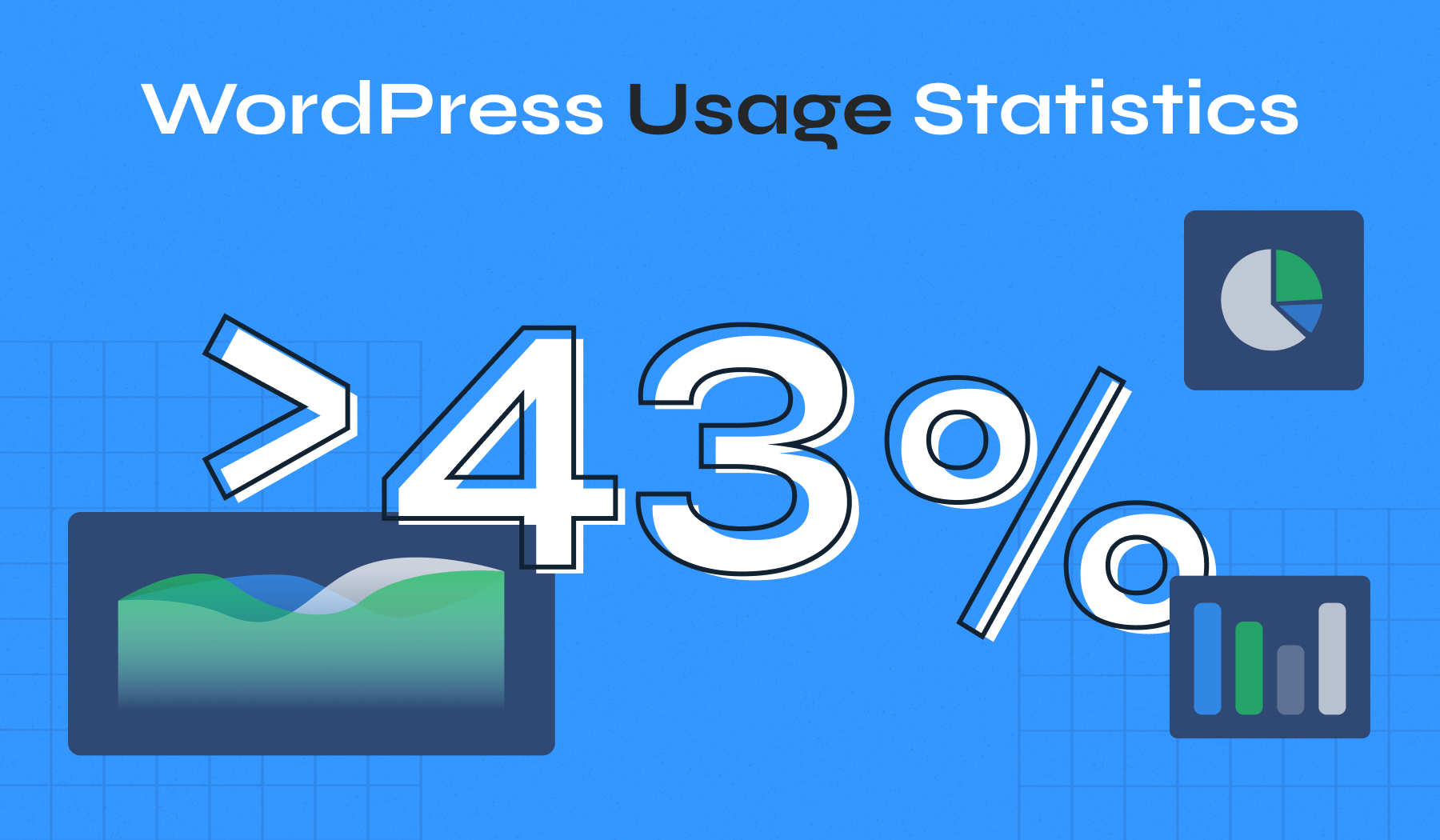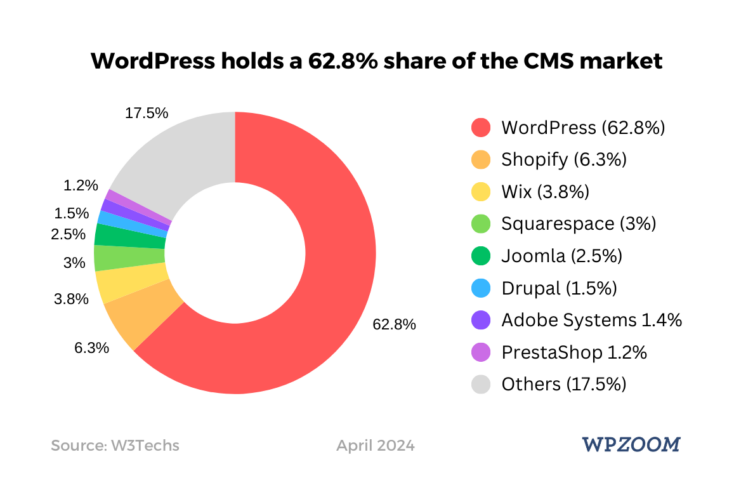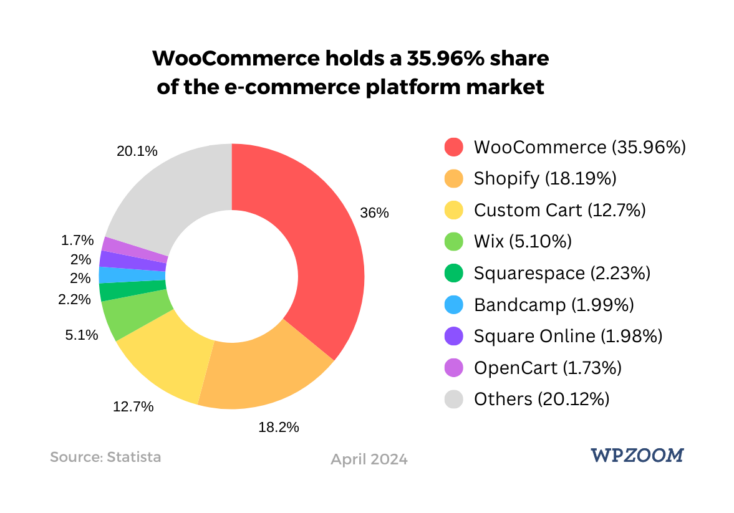
WordPress started as a basic blogging tool in 2003. Now, it’s the backbone for many websites, ranging from local startups to global enterprises.
WordPress’s growth over the years is impressive. By examining how people use WordPress, we learn about web trends, user preferences, and the future of managing online content.
WordPress statistics reveal successful strategies, popular features, and areas needing improvement. We’re covering everything from its market share to its user base to the plugins and themes that add to its flexibility.
Let’s look closer at the specifics, focusing on how many websites use WordPress today.
Quick Facts: WordPress Statistics in April 2024
- WordPress powers 43.3% of all websites as their CMS.
- Around 472 million websites are built on WordPress.
- WordPress dominates the CMS market with a 62.8% share.
- There are over 30,000 WordPress themes available.
- More than 70,000 plugins are available for WordPress.
- WooCommerce is the top e-commerce platform, holding a 35.96% market share.
What Percent of Websites Use WordPress?
As of April 2024, a remarkable 43.3% of all websites globally use WordPress.

W3Techs’ latest data confirm WordPress’s leading position as the go-to content management system (CMS). This statistic isn’t merely about its popularity. It underscores WordPress’s critical influence on digital content creation and management worldwide.
How Many Websites Use WordPress?
As of April 2024, more than 472 million sites use WordPress.
Understanding WordPress’s impact in 2024 requires a deep dive into website usage statistics.
NetCraft’s report from March 2024 shows a total of 1.09 billion websites. This includes everything from personal blogs and company sites to online stores and social networks.
With 43.3% of all sites built on WordPress, we see its massive footprint. Applying this to NetCraft’s totals, more than 472 million websites globally run on WordPress.
The significance of these numbers is amplified when considering WordPress’s position within the CMS market.
What Is the WordPress CMS Market Share?
When we focus on sites with an identifiable CMS, WordPress’s share jumps to 62.8%. This level of market control goes beyond dominance, nearing a monopoly in the CMS world.

Shopify and Wix, WordPress’ nearest rivals, trail significantly with shares of 6.3% and 3.8%, respectively. This highlights WordPress’s unparalleled lead.
Additionally, it’s interesting to note that 31% of the internet functions without a recognized CMS, showing a wide variety of web development approaches. Yet, among websites choosing a CMS, WordPress’s leadership is clear.
Its consistent innovation and ability to respond to the web’s evolving needs have cemented its top spot in the CMS market.
Source: W3Techs
WordPress Historical Growth Trends
The rise of WordPress to the top of the CMS world is a story of continuous growth and evolution. An analysis from W3Techs outlines WordPress’s expanding influence year after year.
The adoption of WordPress has impressively surged since January 1, 2013, with a 17.4% usage across all websites. By April 1, 2024, its market share has climbed to 43.3%.

There’s also been a noticeable decrease in websites operating without a recognized CMS, dropping from 68.2% in January 2013 to 31% by April 2024. This indicates a shift towards CMS usage for web development, with WordPress at the forefront of this movement.
How Many WordPress Themes Are There?
As of April 2024, the WordPress.org theme directory contained nearly 12,000 free themes. This figure highlights the dynamic community behind WordPress.
ThemeForest, a top marketplace for WordPress themes, adds another 12,000 paid options to the mix.
Together, these two sources boast over 24,000 themes. Yet, this is just the beginning. Countless free and premium themes are available through various independent theme shops like WPZOOM, significantly expanding the selection.
Given the ever-evolving nature of theme creation and distribution, estimating an exact total is tricky. Nonetheless, a cautious guess would put the overall number of WordPress themes well above 30,000.
What Are the Most Popular WordPress Themes?
The world of WordPress themes is vast and varied. A deep dive into data from BuiltWith.com, focusing on the top 1 million websites, showcases the leading themes:
- Hello Elementor dominates, with 11,500 websites using it. This accounts for a 1.16% share of the top sites.
- Divi is a close second, appearing on 9,927 sites and securing a 0.99% market share.
- Astra is neck-and-neck with Divi, also on 9,870 sites, representing a 0.99% share.
- GeneratePress is chosen by 8,139 sites, making up 0.81% of the top million.
- Newspaper features on 5,278 sites, which is 0.53% of the top websites.
On the Envato Market, the most popular themes are:
- Avada, with 952,000 sales
- The7, reaching 304,000 sales
- BeTheme, close behind with 297,000 sales
- Enfold, with 257,000 sales
- Flatsome, with 234,000 sales
These numbers reflect the preferences and trends within the WordPress theme market.
How Much Do WordPress Themes Cost?
The cost of WordPress themes is variable, accommodating different budgets and requirements. Plenty of free themes are available for those on a tight budget.
Theme prices vary greatly, with some as affordable as $10 and others exceeding $200. The typical price point for a WordPress theme is about $59.
Theme membership subscriptions offer a value proposition for those desiring access to multiple themes through a single purchase. These subscriptions grant entry to a collection of themes. Annual fees for these memberships range from $48 to $399, with the average yearly cost being around $145.
Moreover, some providers offer “lifetime” memberships. This one-time payment model gives members unlimited access to all existing and future themes, eliminating the need for yearly renewals. The average cost for a lifetime membership is approximately $255, making it an appealing option for long-term WordPress enthusiasts and developers seeking extensive theme access for their projects.
Source: CodeinWP
How Many WordPress Plugins Are There?
As of the latest count, there are 59,500 free plugins in the WordPress Plugin Directory and over 5,200 paid plugins on CodeCanyon. Together, these sources account for more than 64,600 plugins.
This number, however, only scratches the surface of what’s available to WordPress users. The WordPress ecosystem is vast, and various third-party sites offer many more plugins.
Given the dynamic nature of plugin development and distribution, pinning down a precise total is challenging. Nonetheless, it’s safe to say the overall number of WordPress plugins likely exceeds 70,000.
What Are the Most Popular WordPress Plugins?
The WordPress Plugin Directory features several standout plugins, each with over 5 million active installations. These include:
- Elementor
- Contact Form 7
- Yoast SEO
- Classic Editor
- WooCommerce
- Akismet
- WPForms
- All-in-One WP Migration
- LiteSpeed Cache
- Really Simple SSL
- Jetpack
- Wordfence Security
These plugins lead in popularity, showcasing the wide array of functionalities sought after by WordPress users.
How Many Websites Use WooCommerce?
In 2023, WooCommerce topped the global e-commerce platform market, holding a 35.96% share. It outpaced Shopify, Custom Cart, and Wix, with shares of 18.19%, 12.7%, and 5.10% respectively.

By April 2024, WooCommerce’s impact on the e-commerce scene remained profound, driving 13.3% of websites with a recognized CMS, or 9.1% of all websites.
With NetCraft reporting 1.09 billion total and 193 million active websites in April 2024, a detailed look at WooCommerce’s reach is possible.
Calculating with the 9.1% rate gives us an insight into WooCommerce’s extensive use: around 99.19 million are powered by WooCommerce.
These figures highlight WooCommerce’s pivotal position in the online commerce arena.
Sources: Store Leads, W3Techs
Final Thoughts
The WordPress stats we’ve reviewed unequivocally confirm its supremacy in web development. Commanding over 43.3% of all websites, WordPress cements its status as the top content management system.
The upward trajectory of WordPress’s adoption, combined with its significant market presence, highlights dependability, ease of use, and extensive support network of themes and plugins.
Looking ahead, WordPress is ready to maintain an influential role on the web, adapting to and serving the diverse requirements of the community.


